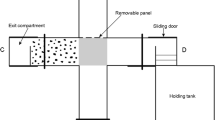Abstract
We investigated whether juvenile freshwater stingrays (Potamotrygon motoro) can solve spatial tasks by constructing a cognitive map of their environment. Two experimental conditions were run: allocentric and ego-allocentric. Rays were trained to locate food within a four-arm maze placed in a room with visual spatial cues. The feeding location (goal) within the maze (room) remained constant while the starting position varied for the allocentrically but not for the ego-allocentrically trained group. After training, all rays solved the experimental tasks; however, different orientation strategies were used within and between groups. Allocentrically trained rays reached the goal via novel routes starting from unfamiliar locations, while ego-allocentrically trained rays primarily solved the task on the basis of an egocentric turn response. Our data suggest that P. motoro orients by constructing a visual cognitive map of its environment, but also uses egocentric and/or other orientation strategies alone or in combination for spatial orientation, a choice which may be governed by the complexity of the problem. We conclude that spatial memory functions are a general feature of the vertebrate brain.












Similar content being viewed by others
References
Ali MA, Anctil M (1974) Retinas of the electric ray (Narcine brasiliensis) and freshwater stingray (Paratrygon motoro). Vis Res 14:587–588
Aronson LR (1951) Orientation and jumping behavior in the gobiid fish, Bathygobius soporator. Am Mus Novit 1486:1–22
Aronson LR (1971) Further studies on orientation and jumping behaviour in the gobiid fish, Bathygobius Soporator. In: Adler HE (ed) Orientation: sensory bases. Ann N Y Acad Sci 188:378–392
Braithwaite VA (1998) Spatial memory, landmark use and orientation in fish. In: Healy S (ed) Spatial representation in animals. Oxford University Press, Oxford, pp 86–102
Braithwaite VA, Armstrong JD, McAdam HM, Huntingford FA (1996) Can juvenile atlantic salmon use multiple cue systems in spatial learning? Anim Behav 51:1409–1415
Demski LS, Beaver JA (2001) Brain and cognitive function in teleost fish. In: Roth G, Wullimann MF (eds) Brain, evolution and cognition. Spektrum Verlag, Heidelberg, pp 297–332
Dodd J, Gibson RN, Hughes RN (2000) Use of cues by Lipophrys pholis L (Teleostei, Blenniidae) in learning the position of a refuge. Behav Proc 49:69–75
Dodson JJ (1988) The nature and role of learning in the orientation and migratory behaviour of fishes. Environ Biol Fish 23:161–182
Dücker G, Schrameyer C, Stascheit M (1979) Die Auswirkung der Übungsverteilung auf das Lernen und Vergessen bei Carassius auratus Linne). Z Tierphysiol 51:269–281
Fremouw T, Jackson-Smith P, Kesner RP (1997) Impaired place learning and unimpaired cue learning in hippocampal-lesioned pigeons. Behav Neurosci 111:963–975
Goodyear CP (1973) Learned orientation in the predator avoidance behaviour of mosquitofish, Gambusia Affinis. Behav 45:191–223
Graeber RC, Ebbesson SOE (1972) Visual discrimination learning in normal and tectal ablated nurse sharks (Ginglymostoma cirratum). Comp Biochem Physiol 42A:131–139
Hasler AD, Horrall RM, Wisby WJ, Braemer W (1958) Sun orientation and homing in fishes. Limnol Oceanogr 111:353–361
Hawryshyn CW, Arnold MG, Bowering E, Cole RL (1990) Spatial orientation of rainbow trout to plane-polarized light: the ontogeny of E-vector discrimination and spectral sensitivity characteristics. J Comp Physiol A 166:565–574
Helfman GS, Schultz ET (1984) Social transmission of behavioural traditions in a coral reef fish. Anim Behav 32:379–384
Helfman GS, Meyer JI, McFarland WN (1982) The ontogeny of twilight migration patterns in grunts (Pisces, Haemulidae). Anim Behav 30: 317–326
Hughes RN, Blight CM (1999) Algorithmic behaviour and spatial memory are used by two intertidal fish species to solve the radial maze. Anim Behav 58:601–613
Huntingford FA, Wright PJ (1989) How sticklebacks learn to avoid dangerous feeding patches. Behav Proc 19:181–189
Ingle DJ, Sahagian D (1973) Solution of a spatial constancy problem by goldfish. Physiol Psychol 1:83–84
Jarrard LE, Okaichi H, Steward O, Goldschmidt RB (1984) On the role of hippocampal connections in the performance of place and cue tasks - comparisons with damage to hippocampus. Behav Neurosci 98:946–954
Kesner RP, Olton OD (1990) Neurobiology of Comparative Cognition. Lawrence Erlbaum Associates, Hillsdale, pp 475
Kleerekoper H, Timms AM, Westlake GF (1970) An analysis of locomotor behaviour of goldfish (Carassius auratus). Anim Behav 18:317
Kleerekoper H, Matis J, Gensler P, Maynard P (1974) Exploratory behaviour of goldfish Carassius auratus. Anim Behav 22:124–132
Lopez JC, Broglio C, Rodriguez F, Thinus-Blanc C, Salas C (1999) Multiple spatial learning strategies in goldfish (Carassius auratus). Anim Cogn 2:109–120
Lopez JC, Rodriguez F, Gomez Y, Vargas JP, Broglio C, Salas C (2000a) Place and cue learning in turtles. Anim Learn Behav 28:360–372
Lopez JC, Broglio C, Rodriguez F, Thinus-Blanc C, Salas C (2000b) Reversal learning deficit in a spatial task but not in a cued one after telencephalic ablation in goldfish. Behav Brain Res 109:91–98
Nelson JS (1984) Fishes of the world. Wiley, New York
Odling-Smee L, Braithwaite VA (2003a) The influenece of habitat stability on landmark use during spatial learning in the three spine stickleback. Anim Behav 63:701–707
Odling-Smee L, Braithwaite VA (2003b) The role of learning in fish orientation. Fish Fish 4:235–246
O’Gower AK (1995) Speculations on a spatial memory for the Port Jackson shark (Heterodontus portusjacksoni) (Meyer) (Heterodontidae). Mar Freshwater Res 46:861–871
O’Keefe J, Nadel L (1978) The hippocampus as a cognitive map. Oxford University Press Clarendon Press, Oxford
Olton DS, Samuelson RJ (1976) Remembrance of places passed: spatial memory in rats. J Exp Psychol: Anim Behav Proc 2: 97–116
Pitcher TJ, Magurran AE (1983) Shoal size, patch profitability and information exchange in foraging goldfish. Anim Behav 31:546–555
Reese ES (1989) Orientation behaviour of butterfly fishes (Family Chaetodontidae) on coral reefs—spatial-learning of route specific landmarks and cognitive maps. Environ Biol Fish 25:79–86
Reeves CD (1912) Moving and still lights as stimuli in a discrimination experiment with white rats. Anim Behav 7:168–168
Riedel G (1998) Long-term habituation to spatial novelty in blind cave fish (Astyanax hubbsi): role of the telencephalon and its subregions. Learn Memory 4:451–461
Rodriguez F, Duran E, Vargas JP, Torres B, Salas C (1994) Performance of goldfish trained in allocentric and egocentric maze procedures suggests the presence of a cognitive mapping system in fishes. Anim Learn Behav 22:409–420
Roitblat HL, Tham W, Golub L (1982) Performance of Betta splendens in a radial arm maze. Anim Learn Behav 10:108–114
Salas C, Broglio C, Rodriguez F, Lopez JC, Portavella M, Torres B (1996a.) Telencephalic ablation in goldfish impairs performance in a ’spatial constancy’ problem but not in a cued one. Behav Brain Res 79: 193–200
Salas C, Rodriguez F, Vargas JP, Duran E, Torres B (1996b) Spatial learning and memory deficits after telencephalic ablation in goldfish trained in place and turn maze procedures. Behav Neurosci 110:965–980
Teyke T (1989) Learning and remembering the environment in the blind cave fish Anoptichthys jordani. J Comp Physiol A 164:655–662
Tolman EC (1948) Cognitive maps in rats and men. Psychol Rev 55: 189–208
Ulrich JL (1915) Distribution of effort in learning in the white rat. Behav Monogr 2:1–51
Velte F, Fleissner G, Wicker R (2002) Untersuchungen zur Chronoethologie des Pfauenaugenstechrochens (Potamotrygon motoro) – erste Ergebnisse. Verhandlungen der Gesellschaft für Ichthyologie 3: 119–129
Warburton K (1990) The use of local landmarks by foraging goldfish. Anim Behav 40:500–505
Acknowledgements
We would like to thank M. Hofmann, J. Mogdans and M. Barker for valuable comments on the manuscript and Slava Braun for animal caretaking, maintenance and repairs. We are specifically grateful to Mr. Wicker from the Frankfurt Zoo for supplying twelve of the animals used during this study, providing animal food and for giving advice on animal caretaking and maintenance. The research reported herein was performed under the guidelines established by the current German animal protection law.
Author information
Authors and Affiliations
Corresponding author
Rights and permissions
About this article
Cite this article
Schluessel, V., Bleckmann, H. Spatial memory and orientation strategies in the elasmobranch Potamotrygon motoro. J Comp Physiol A 191, 695–706 (2005). https://doi.org/10.1007/s00359-005-0625-9
Received:
Revised:
Accepted:
Published:
Issue Date:
DOI: https://doi.org/10.1007/s00359-005-0625-9




